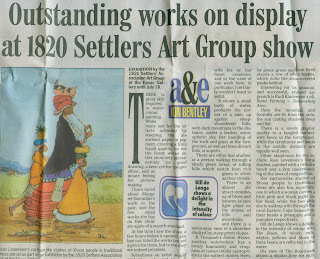In the wake of the controversy that has erupted surrounding South African artist Brett Murray's painting, 'The Spear', I thought I'd post some pieces I did around 2005, at the height of the Thabo Mbeki era. The works continue a theme I have been propounding since not long after Mbeki took the reins in 1999. (To view them bigger, press shift and left click. Left click again to see them larger still.)
I came across some 1950s and 1960s South African postage stamps - the sort I grew up with as a child - and decided that they represented, in a way, something of the progress our country had made since the arrival of the European colonists. So the new flag is comprised of stamps from the old South Africa, while the whole is surrounded by the colours of the old flag, the Oranje Blanje Blou.

Interestingly, I submitted this work for the 2005 Kebble art exhibition. I was notified on my cellphone that it had been accepted, but later, when I went to pick up the other works I had submitted for an exhibition at the EP Society of Arts and Crafts Gallery in Port Elizabeth, I was told it had in fact not been selected. Should I be surprised at this change of mind, given that this work, which I called 'Between the Lines', does not really square with the sort of politically correct philosophy that Kebble, who was shot dead in mysterious circumstances in September 2005, espoused, given his close ties to the ANC Youth League.

Those who've been following this blog will have read some of the articles I wrote in the Herald, Port Elizabeth, attacking Mbeki's shocking policy of appeasement towards Zimbabwe's President Robert Mugabe. Anyway, in this work, called 'A Helping Hand', I used a press photograph of the two of them at the height of Mugabe's reign of terror - when white farmers were driven off their farms, newspapers were shut down, political opponents were attacked - to again make the point, using stamps from the former Rhodesia, that without the successful country built up by those early colonists, he would not have any of the riches he enjoyed/enjoys as a dictator. The bits of coloured paper used to fashion the shape of Zimbabwe are actually the torn-off pieces of envelope from which I removed the stamps. In one you can make out part of the franking of the name, Bulawayo.

Pardon the reflective glass, but I thought I'd give another view of this work. Note the colours of the ANC surrounding this image. My point is that our destinies are all interlinked.
The camera I'm using is what one would call fairly inexpensive, hence it does not give the sort of perfectly rectangular shapes necessary for photographing works of art. Here I have tried to show Mbeki and Mugabe's role in turning Zimbabwe inside out and upside down, destroying its economy and trampling on human rights. Just recently, on the PE beachfront, the African people selling arts and crafts from around the continent, were also selling the ridiculous banknotes that Mugabe was having printed as inflation surged into the millions. I wish I'd bought a 100 trillion dollar note - but I wasn't prepared to fork out the R30 or so it was going for.
I called this 'Occupational Hazard', based on the two bottom stamps. Note how the cityscape stamps have also been inverted, to underscore the country's upheaval.
The ANC is 100 years old this year. But for most of those years it existed in a country, yes which was beset by racism, but also one that achieved much and produced stamps celebrating things like commercial agriculture.
Interesting, isn't it, that the hand holding the spear in the ANC logo is white. Perhaps a tribute to Joe Slovo.
This, called 'Quo Vadis', I did in 2006, with Zim's descent into oblivion continuing apace. Some of the stamps are from an earlier colonial era, but all make the point of the origins of those states.
Another view of 'Quo Vadis' showing how I incorporated the colours of the Zim flag into the work.
As noted on an earlier blog, I picked up a couple of black bags full of old stamps and envelopes. I like the thought that stamps were carefully, or not so carefully, stuck on envelopes or parcels, handed in at a post office, franked, and then the parcel or envelope was sent to its destination. So each stamp, or group of stamps, contains a story. This one I called 'Secretary Bird' after the stamp.
This is exactly as the paper was cut by whoever, back in the 1960s, decided to keep these stamps. I've called it 'Barclays' because, though not visible here, the bank's name was embossed in the red wax seal.
In earlier postings, I have shown a plethora of envelopes with old SA stamps and names of companies on them. These were done in 2005, before I even started this blog. This one I called 'City Treasurer' for the destination of these envelopes.
Another layer of government in the 1960s gave rise to the destination of these. I call the work 'Divisional Council'.
In this one, called 'Buffalo', I incorporated a particularly pleasing envelope and large array of stamps. I like the way the buffalo logo on the left faces off against the wildebeest stamp on the right. Those stamps I recall as being from the 1950s, before we became a republic. Indeed, though I can't make out the date on the franking mark, I see the stamp is for one penny.
And then there is this. As yet untitled, I have been working on this abstract for the past few months.




















































